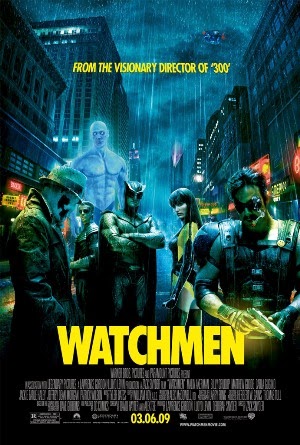 All right! So this week we talk about the comparisons between last week's blog subject and its portrayal in the 2009 film by Zack Snyder.
All right! So this week we talk about the comparisons between last week's blog subject and its portrayal in the 2009 film by Zack Snyder.First of all, let us note that the film is essentially the closest thing to an onscreen adaption we will ever get. The story, barring the film's final act, is verbatim the story told within the graphic novel; in fact you can see that the film uses almost the EXACT same dialogue, as well as the exact same camera angles. For that matter, the casting was spot on, Rorschach's voice in the film was EXACTLY what I had in mind whilst reading the graphic novel.

 Last week, I spoke mostly about Rorschach, what it means to be a "hero" and the thematic ramifications of the ending, and, in this regard, Watchmen lost none of this in translation to the film medium. Rorschach did exactly what Rorschach did in the graphic novel, definition of the term "hero" is still relative; Veidt saved the world but in an evil manner, but Rorschach was willing to liberate the world from this lie, albeit in the process doom it yet again.
Last week, I spoke mostly about Rorschach, what it means to be a "hero" and the thematic ramifications of the ending, and, in this regard, Watchmen lost none of this in translation to the film medium. Rorschach did exactly what Rorschach did in the graphic novel, definition of the term "hero" is still relative; Veidt saved the world but in an evil manner, but Rorschach was willing to liberate the world from this lie, albeit in the process doom it yet again. Although, the one difference the movie had from the graphic novel that may actual have some thematic significance is the ending. In the Watchmen movie, Veidt kills a vast number of the population by using a device, that deceptively looks like Dr. Manhattan's handiwork, all around the world in massive explosions. In the graphic novel, however, Veidt used his resources to create a false alien entity, teleport it to New York, and kill half the city with a psychic shock wave, as it died. The only reasons for this change, that occur to me, are that it gives the audience a less radical notion, and it shifts the blame of the newly united world onto Dr. Mahattan, as opposed to a totally unreal enemy. Fundamentally, this changes nothing. The world is still united, Dr. Manhattan and the gang, except for Rorschach, still acknowledge the gravity of the event and agree to keep it a secret., and Dr. Manhattan still leaves the Earth, permanently, after said events.
Although, the one difference the movie had from the graphic novel that may actual have some thematic significance is the ending. In the Watchmen movie, Veidt kills a vast number of the population by using a device, that deceptively looks like Dr. Manhattan's handiwork, all around the world in massive explosions. In the graphic novel, however, Veidt used his resources to create a false alien entity, teleport it to New York, and kill half the city with a psychic shock wave, as it died. The only reasons for this change, that occur to me, are that it gives the audience a less radical notion, and it shifts the blame of the newly united world onto Dr. Mahattan, as opposed to a totally unreal enemy. Fundamentally, this changes nothing. The world is still united, Dr. Manhattan and the gang, except for Rorschach, still acknowledge the gravity of the event and agree to keep it a secret., and Dr. Manhattan still leaves the Earth, permanently, after said events. Besides the plot materials as well as the thematic materials, one of the chief differences from the graphic novel and the movie are the fundamental differences between any adaptation. The graphic novel provides better tone and structure because it is able to convey color schemes that affect our emotions and understanding. Also, with it's structure, it is able to convey higher literary concepts than could be done in film. My prime example is Dr. Manhattan's chapter in Watchmen. In the graphic novel, it conveys Dr. Manhattan's sense of "time" much better than it does in the film; in the film it felt mostly like narrated flashbacks. So in this regard, the book is a much better medium.
Besides the plot materials as well as the thematic materials, one of the chief differences from the graphic novel and the movie are the fundamental differences between any adaptation. The graphic novel provides better tone and structure because it is able to convey color schemes that affect our emotions and understanding. Also, with it's structure, it is able to convey higher literary concepts than could be done in film. My prime example is Dr. Manhattan's chapter in Watchmen. In the graphic novel, it conveys Dr. Manhattan's sense of "time" much better than it does in the film; in the film it felt mostly like narrated flashbacks. So in this regard, the book is a much better medium.
No comments:
Post a Comment